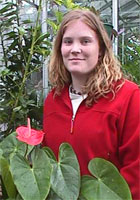|
Crystal Idioblasts
in the Flowers of Aroids
An entire book has been written on the structure of the leaves and
stems of plants in the Aroid family, including their crystals (Anatomy
of the Monocotyledons. IX.
Acoraceae and Araceae by R. C. Keating, 2002).
However, very little has been published, that I can find, on crystals in the
flowering tissues. We have been looking at plants from various genera
throughout the family, looking for crystals in the flowering tissues.
|
|
 |
|
We have examined aroids from greenhouses, private homes, and the wild.
So far, besides Dieffenbachia, we have examined Anthurium (3
secies), Spathiphyllum (peace lily), Arisaema (Jack-in-the-pulpit), and
Symplocarpus (skunk cabbage). We were also able to collect
material from Virginia Tech's titan arum (Amorphophallus titanum)
when it bloomed in 2004. This species has the largest unbranched
inflorescence of any plant in the world. Andrea McConnachie, Brad Howard
and Bob Mills have helped with this project, and Kristina Webb (right, with
Anthurium andraeanum) did all the work so far on the genus
Anthurium.
Below, a (so-far) unidentified species of Anthurium from the RU
greenhouse. The top pictures show leaves and the inflorescence.
The bottom pictures show male (left) and female (right) flowers under
polarization microscopy to reveal the crystals. |



